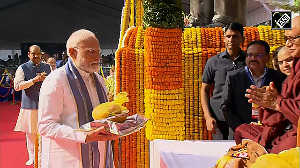The fast moving consumer goods sector has staged a smart turnaround, growing at over 5 per cent for the past two years after a 1-2 per cent growth in the previous three years. As a result, FMCG stocks have appreciated phenomenally in the past two years.
If the FMCG sector does well, will its suppliers also earn handsome returns for their shareholders? The Rs 500-crore (Rs 5 billion) Paper Products is one such company, being a one-stop shop for total packaging solutions of consumer packaging.
It is in the flexible packaging business and also offers other services like labelling technologies and specialised cartons and holographic options. The world's sixth largest consumer packaging company - Huhtamaki holds 59 per cent stake in the company. Its clientele includes FMCG heavyweights like HLL, Colgate, Nestle, Britannia, Coca Cola, Dabur, P&G and Amway.
PPL meets the packaging needs of almost the entire range of FMCG segments including personal products, laundry, foods, beverages, bakery products, spices, chocolates and dairy. Its packaging uses technologies such as shrink sleeves, wraparounds, heat transfers, pressure sensitive and metallised paper labels.
Manufacturing of specialised cartons and cartooning systems, manufacture of poly films, specialised barrier metalising and high-end application extrusion coating are also part of PPL's product offerings.
The company is mainly into higher end of its target market with 45 per cent market share. It has a strong presence in south and west India.
In order to enhance its presence in other parts of the country, the company is planning to set up a facility in the North, which is the second largest market in India after the West.
It is also trying to widen its customer base and diversify the business risk by catering to smaller players for a good reason.
Ravi Chidamabaram, controller (finance) of PPL says, "Even in its worst times when the FMCG sector saw almost no growth in FY04, some small companies grew at a strong rate of 30-40 per cent. This is because of lower business risk for smaller players."
Despite having leadership in its market segments, PPL does not have much pricing power.
This is because it is unable to bargain for lower raw material prices from its suppliers like Reliance due to relatively small requirements and its large-sized customers having better bargaining power on the pricing side. Also, there is increased competition due to a number of players entering its markets.
Spiralling prices of raw materials like polymers, which have risen by about 30 per cent in 2005 and are expected to stay firm, is also a concern.
Chidambaram says, "Going forward, there is unlikely to be a further rise in raw material prices due to new capacities coming up in the Asian region, Also, recent cuts in the import duties of polymers from 10 per cent to 5 per cent will help to some extent."
PPL is constantly on the lookout for new and innovative products and applications. Every year nearly 25 per cent of its revenues come from these new ideas. Chidamabaram says: "We intend to maintain this proportion in future and also plan to spend 5 per cent of sales on R&D."
Cost increases are difficult to pass on as PPL's bargaining power with respect to major clients like HLL and Nestle is weak. A number of competitors have appeared in the packaging industry leading to price undercutting.
This further limits PPL's ability to increase prices to offset costs. Since its buyers are not retail customers but large corporates, buying is less driven by impulse and PPL's brand is not as strong as any of its clients.
In addition, the packaging industry is relatively capital intensive compared to consumer non-durables. For instance, PPL generated sales twice the total capital employed, while HLL generated sales more than 4 times total capital employed.
In the year ended December 2005, the company posted a reasonably good performance. The company reported a sales growth of 9.9 per cent to Rs 432.86 crore (Rs 4.33 billion). This was due to discontinuation of un-remunerative business and uncertainties regarding VAT.
Its operating profit increased by 7.5 per cent to Rs 54.68 crore (Rs 546.8 million) in the same period. Operating profit margin remained flat at 12.6 per cent due to the unprecedented rise in raw material prices. Profit after tax rose by 14.77 per cent to Rs 27.67 crore (Rs 276.7 million) and net profit margin improved from 6.1 per cent to 6.4 per cent during the same period.
The PPL stock has almost doubled on the BSE from Rs 212 to Rs 425 in the past year keeping in line with the market return of 90 per cent. At its current market price, the stock trades at a P/E multiple of 19.26.
Analysts say, "Though the valuation looks a bit stretched, the company is expected to witness robust volumes with rapid growth in its user industries like FMCG, food processing and retail."
With its expanding client base, continuous product innovation, PPL is likely to remain a clear leader in packaging products.
But the decision to buy the stock should be made on its intrinsic merits and available valuations (which are reasonably stretched at present) and not because it is a proxy play on the FMCG sector. The correlation may extend to sales growth, but not necessarily to profit growth.







 © 2025
© 2025